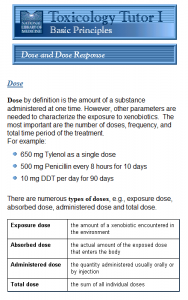Original article appeared in the Scientific American Blog “60-Second Science“, by David Biello
 There are some 82,000 chemicals used commercially in the U.S., but only a fraction have been tested to make sure they’re safe and just five are regulated by the U.S. Environmental Protection Agency (EPA), according to congressional investigators. But a government scientist says there’s no guarantee testing actually rules out health risks anyway.
There are some 82,000 chemicals used commercially in the U.S., but only a fraction have been tested to make sure they’re safe and just five are regulated by the U.S. Environmental Protection Agency (EPA), according to congressional investigators. But a government scientist says there’s no guarantee testing actually rules out health risks anyway.
The basic premise of safety testing for chemicals is that anything can kill you in high enough doses (even too much water too fast can be lethal). The goal is to find safe levels that cause no harm. But new research suggests that some chemicals may be more dangerous than previously believed at low levels when acting in concert with other chemicals.
“Some chemicals may act in an additive fashion,” Linda Birnbaum said this week at a conference held at the Columbia Center for Children’s Environmental Health at Columbia University. “When we look one compound at a time, we may miss the boat.”
Birnbaum, director of both the National Institute for Environmental Health Sciences (NIEHS) and the National Toxicology Program in Washington, D.C., noted that some chemicals, such as those that mimic human hormones, may combine with other hormonelike chemicals at low doses to produce big effects.
For example, bisphenol A (BPA), a primary component of some plastics, reacts with cells in the same way as the female hormone estrogen and could be acting synergistically with other pseudoestrogens in the bloodstream to produce heart disease, diabetes or liver failure. Such effects have been observed in animal studies in the lab as well as in frogs in the field for chemicals ranging from the phthalates (used to help perfumes scent linger and make plastics soft) to ubiquitous herbicides like atrazine, linked to malformation in frogs.
In fact, Birnbaum says, there may be no safe dose of certain compounds. For example, lead, a potent neurotoxicant, has been disappearing from the bloodstreams of American children since the 1970s when it was phased out of gasoline and paint. But some children are still exposed to low levels from old, peeling paint and its effects on intelligence and behavior can still be seen. “There is no safe level of lead,” Birnbaum noted.
(more…)


 There are some 82,000 chemicals used commercially in the U.S., but only a fraction have been tested to make sure they’re safe and just five are regulated by the U.S. Environmental Protection Agency (EPA), according to congressional investigators. But a government scientist says there’s no guarantee testing actually rules out health risks anyway.
There are some 82,000 chemicals used commercially in the U.S., but only a fraction have been tested to make sure they’re safe and just five are regulated by the U.S. Environmental Protection Agency (EPA), according to congressional investigators. But a government scientist says there’s no guarantee testing actually rules out health risks anyway.